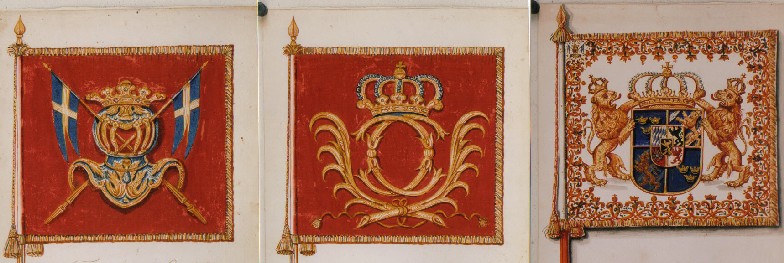|


The most
valuable possessions a regiment owned were their colours which were carried
in every battle and marked the place of each unit in the battlefield. The
colours were made with expensive material and artistic decorations in order
to show the status of the regiment. To lose the colours was a great shame
and conquering the enemy's colours was a great honour. For this reason it
was usually near the colours where the hardest fighting occurred and
soldiers were required to swear an oath to never abandon the colours.
Depending on
troop type the colours had different shape and size. The infantry colours
were very large. In the Swedish army during the Great Northern War, these
were in average 1.84 metre high and 2.16 metre wide.
The cavalry colours were square shaped and considerably smaller, each side of
the square just little more than a half metre long. The Swedish cavalry also
usually had two different motifs on the obverse and reverse side of the
standards, i.e. a provincial coat of arms on the obverse and the royal
cypher on the reverse side. This arrangement was also true for the dragoons
who officially was mounted infantry but in practise functioned as cavalry.
The dragoon colours had however a different shape and size of their colours.
These were swallow tailed and had a height of about a metre and a slightly
longer width.
Regardless of
troop type each Swedish company had their own colour during the Great
Northern War, which meant that a typical regiment would have eight colours
or standards. Seven of these were called company colours or company
standards while the colonel's company ("livkompaniet") had a "livfana" or
"livstandar" (= colonel's colour) which was always white. After the Great
Northern War the number of colours was reduced to two per battalion (which
consisted of four companies) while the cavalry and dragoons continued to
have one colour for each company. Then in the 19th century the number of
infantry colours was yet again cut in half so that each battalion would
carry just one colour. Later it was decided that all regiments would only
have one colour each, but at that time the colours had for a long time only
had symbolic importance.
However, during
the Great Northern War the colours were still of great importance. And in an age
where it was hard to find reliable information about the outcome of a battle,
the number of conquered colours were compelling evidence of victory which
were presented to the people and foreign ambassadors. Likewise, it was hard
to conceal defeat when an army had lost many colours.
In Sweden it was
for a long time the regimental commanders who decided on how the colours were
to be designed. But in the 1670s the colour patterns became regulated by the
king, which resulted in the wide scale use of provincial coat of arms in the
Swedish colours and standards. The most famous of these regulations was the
one from 1686 which more or less would remain in use until 1766. Alongside
the regulations, model drawings of the colours and standards were produced
as an aide to manufacturers. The preserved model drawings are part of the
Swedish War Archive's collection "fanritningar" which I have
photographed and published on this website (see links in the left column).
It was however
not always the case that the colours conformed to the model drawings so the
preserved colours and standards need to be studied as well.
Complete lists of preserved colours and standards can also be found in the
left column and for those that are a part of the Swedish Army Museum's
collection I have also added links showing how they looked. I hope that
other museums will digitalise their collections as well so that I can add
links top their colours too.
The images above are the
model drawings showing how Nyland Cavalry Regiment's standards should look
like according to m/1686. The two red to the left show the obverse and
reverse side of the company standards. The white standard to the right is
the colonel's standard which like all m/1686 colonel's colours and standards
contained the Swedish coat of arms in the centre and the individual
regiment's provincial coat of arms in the upper inner corner.
|

